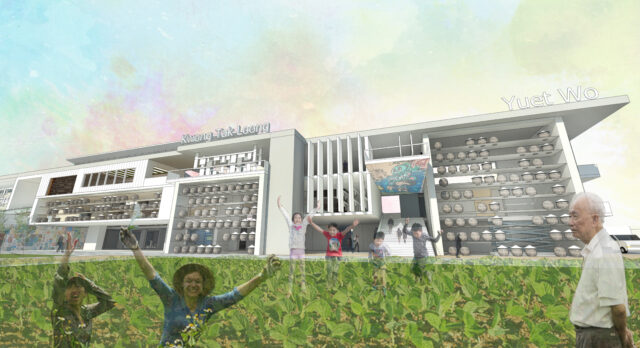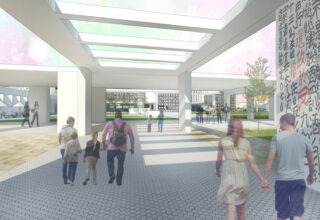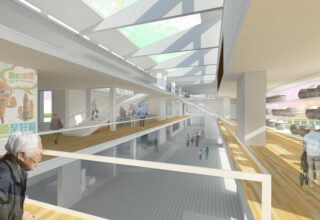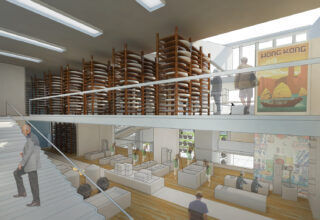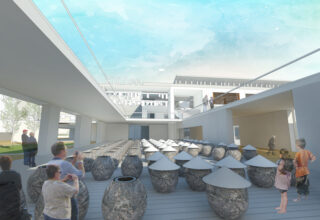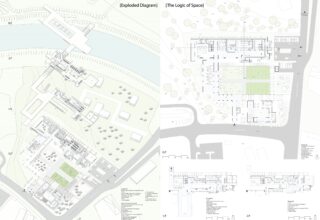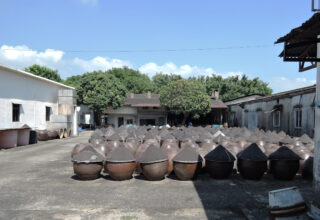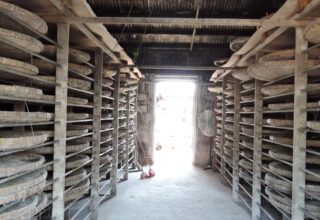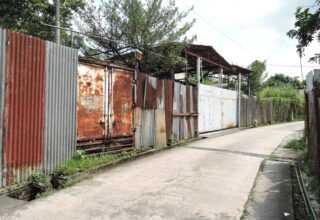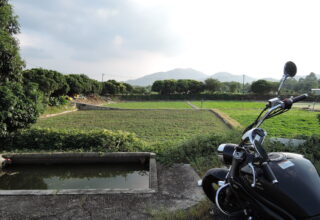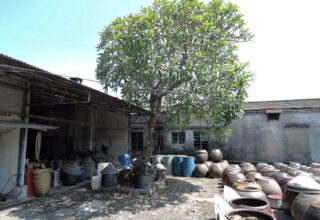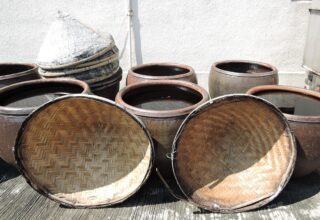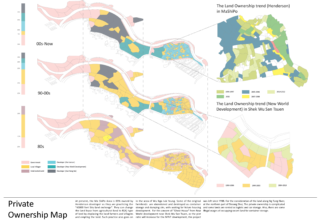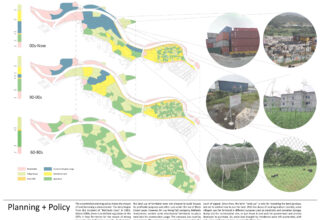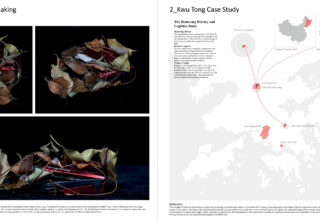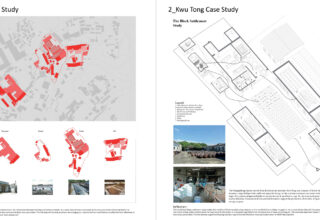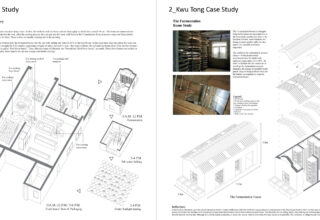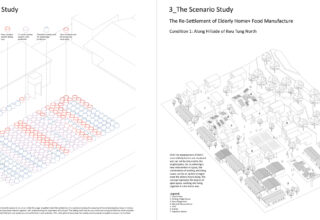The Soya Loca in Kwu Tung
A place for cultivating Local Soya-food prodcution
Food Factory_Kwu Tung
前往廣德隆醬油廠,可分別於上水港鐵小巴及巴士總站搭乘51B小巴或76k巴士。 然後,您可以在古洞巴士站下車。之後往古洞蔬菜合作社方向走進村。然後,經過四個村道路口,就可以到達醬油廠。
【大豆Loca】: 保存傳統大豆食品生產
【主張】
該項目旨在恢復大豆食品生產文化,保護傳統食品工藝。它與當地上水圍村民合作,研究大豆食品生產工藝,將老年人和家人聚集在一起,支持社會企業。
【項目意向】
擬建一個大豆食品試驗場,將庭院和村民公共空間相連接,並結合貿易、辦公和生產空間,以集體農業經營為理念,支持不同社會組織,鼓勵食品工藝,展示生產效率之美。
【地點】
項目位於上水圍傳統村落與梧桐河自然景觀之間。它與村民密切聯繫和參與生產。同時,也讓遊人欣賞江邊的美景。毗鄰文錦渡管制站,方便派送。
【建築學】
整體建築設計是構造為有趣的立體空間,設計加減方法是營造出不同的庭院空間,增強工廠的空間感和通風。關鍵是將生曬黃豆空間從水平地面轉變為垂直,以創造一個引人入勝的食品生產示範。在空間規劃上,入口層為休閒、商業和教育用途,中間為生曬空間和參觀路徑。最終,建築的主幹是一條食品生產線。
【項目背景】
新界東北的開發商,霸權給當地村民造成了不公平。主要是3個開發商佔據了超過55萬平方米(佔整個開發面積的90%),而公共住房僅佔6%(損失了96%的可用農田)。該行動涉及搬遷石仔嶺安老院,搬遷900名長者,失去農地和食品廠,特別是當地的廣德隆醬油廠和古洞北其他與豆類食品相關的生產中心。
觀察現時新界東北區的土地用途,部分土地被閑置為貨櫃倉及停車場,並放棄農業耕作。此外,傳統豆製品生產的衰敗也令人遺憾,因為它將逐漸被大規模生產的機械食品工廠所取代,從而造成“食品正義”的不平等。屆時,古洞北的五家主要豆製品生產廠將在新東北地區轉移到內地,削弱我們珍視50年的豆製品工藝。
然而,香港在傳統食品保鮮方面有著豐富的經驗,在此創造機會,與附近的村莊重新聯繫,並將大豆食品生產重新引入粉嶺北區,有助增強社區凝聚力,並將食物工業傳統的知識傳給下一代。
【設計說明摘要】
該項目探討了保護大豆食品傳統工業的可能性,以有機城市的理念實踐農業。由於新界東北新城開發將拆除大部分的農田和小型食品工廠,因此人們建議在開發與保護之間取得平衡,強調“社會責任”和“食品正義”。未來20年,隨著人口老齡化的加劇,大豆食品產業平台勢在必行。
To arrive at Kwong Tak Loong Soya Factory, you can take minibus 51B or bus 76k from Sheung Shui MTR Minbus and Bus Terminals respectively. Then, you can get off at Kwu Tung bus station. After that, walk towards to the Kwu Tung Vegetable Co-operation and go into the village. Finally, by passing through four intersections, you can reach the Soya Factory.
[The Soya Loca]: The Place for preserving traditional Soya-food production practice
Project Statement
[Proposition]
The project targets at bringing back the loss of cultural identity of Soya-food production and preserving traditional food craftsmanship, together with regenerating the food production ecology for establishing local branding. It examines the feasibility to recapture the soya-food production crafts and bring elderly and family together with working on with local organizations and Sheung Shui Wai Villagers.
[Programme]
A Soya-food testing ground is proposed with interconnecting courtyard and communal space for villagers, in combination with trade, office and workshop. It is a venue for post-procedure of Soya food factory, with the idea of collective agricultural operation. It is also a place for different social organizations to support social enterprise towards soya-food factory, thus encouraging the idea of self-sustained food ecology, with demonstrating the beauty of traditional production.
[Site]
The project locates in between the traditional villages of Sheung Shui Wai and the natural landscape of Ng Tung River. It acts as a buffer and brings up close connection with villagers for production participation. At the same time, it allows visitors to enjoy the beautiful scenery of riverside. It is adjacent to Man Kam To Road, with close proximity to Man Kam To Control Point for convenient delivery.
[Architecture]
The overall design is the playful of shifting tectonics in solid and void spaces. The addition and subtraction of space creates different courtyards for enhancing the spatial and ventilation of factory space. We convert the sun-drying space from horizontal ground to vertical sun-drying blocks to demonstrate the static sun-drying practice. In terms of spatial planning, the entry foyer with large open space for leisure, commercial and educational purposes. Visiting path is circulated among the sun-drying and soya-sauce production. Eventually, the backbone of the architecture is a line of expressing the food production.
[The Background of the project]
The Developer Hegemony in NENT creates unfairness for local villagers, with mainly 3 developers occupying over 550000 sq. m (90% of whole development), with only 6% for public housing (loss of 96% of usable farmland). Such action involves the removal of Elderly Home in Shek Tsai Ling, in displacing 900 elderly and losing agricultural land and food factory, in particular the local Guang Tak Loong Soya-Sauce Factory and other Soya-food related production centres in Kwu Tong North.
With observing the current land use in NENT, some lands are abandoned as container storage and car parking, with giving up the local agricultural practice. Also, the decay of traditional soya-food production makes a pity for the community. By then, it is assumed that the five-major soya-food production factories in Kwu Tong North would be displaced to mainland under the NENT, hence diminishing our soya-food craftsmanship which we have been cherished for 50 years.
Then, the loss of traditional soya-food practice would diminish the agricultural self-sufficiency rate. The local family-oriented soya factory will be displaced to mainland China, thus diminishing local food culture.
Hong Kong has a rich background in traditional food preservation. Here, we create an opportunity to reconnect the villages and make an intervention that a soya-food production factory can be re-introduced into Fanling North Area to benefit the agricultural practice. It helps developing community cohesion and sustaining food knowledge to different generations.
[Summary of Design Statement]
This project examines the possibility in preserving the traditional heritage of soya-food industry in responding the idea of Organi-City and achieving the ecology for experimental productive landscape and agricultural practice. As the new town development of NENT would demolish most of the usable farmland and small-scale food factories, it is prominent to preserve such cultural heritage as people are strongly against the idea of “Food Hegemony” by big companies. So, the project is restoring the value between development and conservation, with achieving strong emphasis on “Social Responsibility” and “Food Justice”. As the ageing population is growing in the following 20 years, it is essential to provide a platform for elderly to support the small-crafted food industry.
[Analogy]
The body is our general medium for having a world with the respect of ground. Sunlight and Nature are the dynamic and continuous systems that builds up the connectivity between human activity and regenerative ecology. The traditional soya-food industry with food practice is a way to touch the spirit of sunlight (Sun-drying) and nature, sharing our world to the sky…
